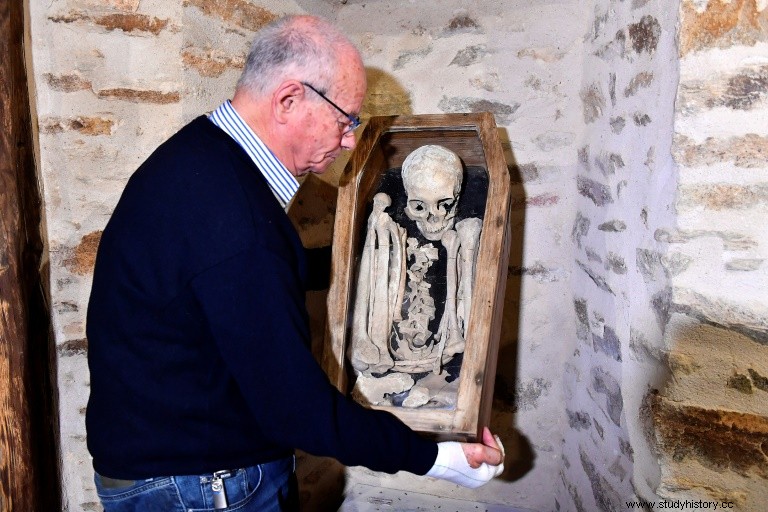A carbon 14 analysis made it possible to date this skeleton, exhumed a century ago in the Dordogne, from 600 or 700 years, sweeping away the century-old local legend and which designated a gentleman of bad reputation, Ernest de Fontaubert.

The skeleton baptized "Ernest", found in 1913 under the floor of a cellar in an outbuilding of the Montcigoux manor, in Saint-Pierre-de-Frugie, on November 28, 2019
Science has spoken and "Ernest" is therefore not "Ernest". A carbon 14 analysis made it possible to date this skeleton, exhumed a century ago in the Dordogne, from 600 or 700 years old, sweeping away the local legend which designated a gentleman of bad reputation who lived in the 19th century. "Ernest", as he was nicknamed by the local novel, was discovered in 1913 under 20 cm of earth by masons who were digging a cellar in an outbuilding of the Montcigoux manor, in Saint-Pierre-de-Frugie, on the borders of the Dordogne and Haute-Vienne, in the heart of Périgord Vert.
The skeleton is not that of the master of the Montcigoux manor who lived in the 19th century
For a century, it had been at the heart of a myth firmly anchored in collective imaginations. Many curious people and history buffs leaned over the bedside of this amazing tenant, now sealed in his glass coffin, hoping to know "who is Ernest?"
Thursday, November 28, 2019, science has destroyed some popular beliefs:a Carbon 14 expertise financed by private funds and carried out by an independent Bordeaux laboratory, Ciram, reveals that the skeleton is not that of Ernest de Fontaubert , master of the manor of Montcigoux who lived in the 19th century, but that of an individual who lived between 1278 and 1388. "Ernest is therefore not Ernest" , announced Thursday Marc Wilmart, former journalist and author of a film in 1987 dedicated to Ernest, and Bernard Aumasson, amateur genealogist who has been investigating the skeleton since 2011. Everything was therefore only "invention" and "manipulation" , they say.

Gilbert Chabaud, mayor of Saint-Pierre-de-Frugie and owner of the Montcigoux manor, in front of the skeleton called "Ernest", November 28, 2019 © AFP - GEORGES GOBET
Ernest never returned to Montcigoux
"It's one hypothesis among many others, but it could be a soldier who fought, laying siege to the castle during the Hundred Years Wars" , killed and "hastily buried", slips Bernard Aumasson, who also evokes the presence of an abandoned cemetery near this site in full front line between the English and the French. Thanks to science, Bernard Aumasson and Marc Wilmart now hope to restore the honor of a family that has been "dirty, dragged through the mud".
At the time of its discovery, the authorities were hardly interested in the skeleton and it was therefore the castellan who inherited the unknown remains. "Ernest" fell somewhat into oblivion, but the affair rebounded in 1933 when a columnist for the Courrier du Center , Antoine Valérie, affirms that the skeleton is that of Ernest de Fontaubert, the former master of the place, who left in 1850 for California with his sister Ernestine. On his return from the Gold Rush, his younger brother Arthur would have murdered him with an axe, a crime inflamed by jealousy and disgust for the incestuous relations that the couple would have maintained.

The Montcigoux mansion, in Saint-Pierre-de-Frugie, November 28, 2019 © AFP - GEORGES GOBET
This legend will be passed down from generation to generation. In 1958, she inspired Robert Margerit in his novel "La Terre aux Loups , and in 1987 the film by Marc Wilmart, Stories of a crime offers him a new sounding board. The medieval tower where the coffin is stored has even become "a place for walking":"every summer vacation, the descendants of the villagers come to visit Ernest" , smiles Gilbert Chabaud, mayor of this village of 450 inhabitants and owner since 1977 of the manor.
At the end of 2011, during Heritage Days, Bernard Aumasson was inhabited by doubt and decided to investigate. In 2013, he embarked on a Californian track, helped by an American genealogist and discovered that Ernest never returned to Montcigoux. He was assassinated in 1862, stripped of the gold he was carrying, and buried near Cave City, Kentucky. In 2016, the skeleton was autopsied by anthropologists from the Criminal Research Institute of the National Gendarmerie (IRCGN) but the research came up against the state of the bones, which were very degraded. For the mayor, the investigations are now "closed". But "it's certain", the legend will survive "with great conviction".
